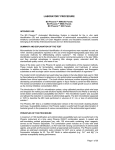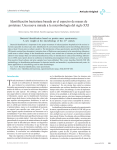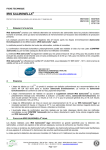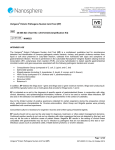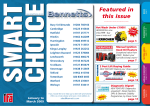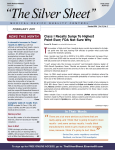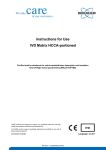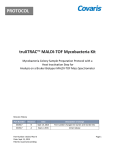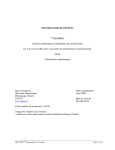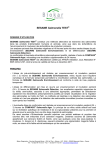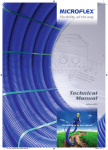Download MALDI Biotyper CA System
Transcript
MALDI Biotyper CA System Clinical Application for Identification of Microorganisms Innovation with Integrity MALDI-TOF In Microbiology, Every Minute Counts The MALDI Biotyper CA System A powerful technology for better results abundant proteins that are found in all microorganisms. To help answer key challenges in Clinical Microbiology, Bruker has utilized its many years of experience to create the truly groundbreaking MALDI Biotyper CA System. With its combination of performance and utility, the MALDI Biotyper CA System will revolutionize the way microbial identification is performed in the clinical microbiology laboratory. The characteristic patterns of these highly abundant proteins are used to reliably and accurately identify a particular microorganism by matching the respective pattern with an extensive FDA-cleared database to determine the identity of the microorganism. Accuracy comparable to Nucleic Acid Sequencing Much faster than traditional methods Cost effective Robust and easy to use A true benchtop system Identifying microorganisms by their molecular fingerprint The MALDI Biotyper CA System identifies microorganisms using MALDI-TOF (Matrix Assisted Laser Desorption Ionization Time of Flight) Mass Spectrometry to measure a unique molecular fingerprint of an organism. Specifically, the MALDI Biotyper CA System measures highly Enterobacter aerogenes Mass Spectrum Profile A Simple Procedure for a Sophisticated Platform Innovative design leads to enhanced performance and productivity The MALDI Biotyper CA System workflow has been designed to be as robust and easy to perform as possible. No previous experience with Mass Spectrometry is required. The workflow has been streamlined and requires only a few simple steps to generate high quality microorganism identifications. Our dedicated microbiology software automates the process of acquiring the mass spectrum and performing the database matching. A report is then generated showing the microbial identification in a very easy to interpret “traffic light” color scheme. Typically no more than an isolated single colony from a culture plate is required, the entire procedure requires only a few minutes to complete providing a report showing the closest matches to the extensive library of microorganisms. Smear using any sterile transfer device Add matrix up to one hour after transfer Select an isolated colony Export result to AST/LIS MALDI Biotyper CA System Sample Workflow Final review by microbiologist Add to MALDI-TOF project list Software automatically generates MALDI-TOF spectrum Spectrum instantly matched against reference database to give identification Easy to Use Software that is Dedicated to Microbiology The wizard A simple to use Real Time Classification wizard guides you through setting up samples for analysis in just a few easy steps. Automatic Calibration and Quality Control Check The MALDI Biotyper CA System microflex LT/SH mass spectrometer is automatically checked using US IVD BTS (Bacterial Test Standard) before each use. When the check is successful, the system automatically begins the measurement process. Run Results Report After the acquisition of the spectral data has been completed, a Run Results Report can be generated. The resultant report for each sample shows the best match along with the respective matching score. Organism identification hints can also be viewed via a hyperlink. Rigorous and Sophisticated Data Analysis Assures Accuracy Meaning of score values Score Values The spectrum of the unknown test organism, acquired through the MALDI Biotyper CA System Software, is electronically transformed into the peak list. Using a biostatistical algorithm, this peak list is compared to reference peak lists of organisms in the reference database and a log(score) value between 0.00 and 3.00 is calculated. The higher the log(score) value, the higher the degree of similarity to a given organism in the reference FDA-cleared database. A log(score) value of ≥ 2.00 can be considered an excellent probability for test organism identification at the species level. The main spectra concept: a reference database developed with the user in mind Reference database entries in the MALDI Biotyper CA System are stored as Main Spectra (MSP). These MSPs are based on multiple measurements of a single defined strain to ensure that the true biological variability of an organism has been captured. An unbiased sophisticated algorithm creates the MSP completely unsupervised by extracting information about peak position, intensity and frequency, while employing very effective denoising and patented mass corrections to the peak data. Unknowns are then compared to the MSP FDA-cleared database using a superior pattern-matching approach that is based on true statistical multi-variant analysis; and includes peak positions, intensities and frequencies ensuring the highest possible levels of accuracy and reproducibility across the complete range of microbes. Reference Strain The Best Technology from the Market Leader in MALDI-TOF The MALDI Biotyper CA System was developed by Bruker, the industry leader in MALDI-TOF technology. These systems were designed as robust, compact, high performance platforms intended for extensive and routine usage. Many outstanding features have been incorporated into the MALDI Biotyper CA System to enhance performance, simplify operation, and extend system lifetime and utility. A true bench-top system—A smart compact design that packs a punch with a throughput of 192 samples an hour. The small access chamber allows for a rapid target insertion that eliminates waiting time between runs. Requires only a 110 V electrical outlet with very minimal heat output. Silent and pleasant operation— With WhisperMode™ you really have a system that can sit on a bench next to you almost silently. By eliminating noisy oil-based vacuum pumps, the vacuum system is not only quiet, but virtually maintenance free. Greatly enhanced sensitivity— With the most sensitive detector technology available (FlashDetector™) you will benefit from having the same high performance technology as large research grade instruments. Powerful and Reliable Performance— Benchtop Convenience microflex LT/SH Mass Spectrometer Dimensions and Operating Parameters LxWxH: Weight: Noise: Temp Range: Operating Humidity: 510 x 680 x 1093 mm [20.1” x 26.8” x 43”] 84 kg (185 lb) net weight < 30 dB under normal operating conditions 10-30ºC (50-86ºF) 15-85% non-condensing @ 30ºC Full spectrum resolution Patented, intelligent pulsed Ion Extraction across a wide protein mass range. This unique technology enhances peak resolution and separation, and mitigates the need for unnecessarily long and bulky instrument flight tubes. MALDI Biotyper CA System and Components Components The standard MALDI Biotyper CA System contains the following components: microflex LT/SH mass spectrometer [P/N: 269944] MALDI Biotyper CA System desktop computer running under Windows® 7 [P/N: 604941] MALDI Biotyper CA System software [P/N: 604512] US IVD 48 Spot Target [P/N: 604532] US IVD BTS [P/N: 604530] US IVD HCCA portioned [P/N: 604531] Package Insert, MALDI Biotyper CA System User Manual [P/N: 603291] Uninterruptible Power Supply (UPS) [P/N: 601463] Instrument: microflex LT/SH Mass Spectrometer Nitrogen Laser with 60Hz repetition rate Full Spectrum Resolution (FSR) with broadband focusing mode (PANTM) FlashDetectorTM WhisperModeTM Oil-free membrane pre-vacuum pump and turbo pump Indication for use The Bruker Daltonics, Inc. MALDI Biotyper CA System is a qualitative in vitro diagnostic mass spectrometer system for the identification of Gram-negative bacterial colonies cultured from human specimens using matrix-assisted laser desorption/ionization time of flight (MALDI-TOF) mass spectrometry technology. The MALDI Biotyper CA System is indicated for use in conjunction with other clinical and laboratory findings to aid in the diagnosis of Gram-negative bacterial infections. The following organisms are claimed: Bruker Daltonics Inc. Billerica, MA · USA Phone +1 (978) 663-3660 Fax +1 (978) 667-5993 [email protected] www.bruker.com Hafnia alvei Klebsiella pneumoniae Klebsiella_oxytoca / Raoultella_ornithinolytica Moraxella_sg_Branhamella catarrhalis Moraxella_sg_Moraxella osloensis Morganella morganii Pantoea agglomerans Pasteurella multocida Proteus mirabilis Proteus vulgaris group Proteus hauseri Proteus penneri Proteus vulgaris Providencia rettgeri Providencia stuartii Pseudomonas aeruginosa Pseudomonas fluorescens group Pseudomonas azotoformans Pseudomonas brenneri Pseudomonas cedrina Pseudomonas congelans Pseudomonas corrugata Pseudomonas extremorientalis Pseudomonas fluorescens Pseudomonas gessardii Pseudomonas libanensis Pseudomonas mandelii Pseudomonas marginalis Pseudomonas migulae Pseudomonas mucidolens Pseudomonas orientalis Pseudomonas poae Pseudomonas rhodesiae Pseudomonas synxantha Pseudomonas tolaasii Pseudomonas trivialis Pseudomonas veronii Pseudomonas putida group Pseudomonas fulva Pseudomonas monteilii Pseudomonas mosselii Pseudomonas plecoglossicida Pseudomonas putida Salmonella sp Salmonella enterica ssp arizonae Salmonella enterica ssp bongori Salmonella enterica ssp diarizonae Salmonella enterica ssp enterica Salmonella enterica ssp houtenae Salmonella enterica ssp indica Salmonella enterica ssp salamae Serratia liquefaciens Serratia marcescens Stenotrophomonas maltophilia Yersinia enterocolitica Yersinia pseudotuberculosis © BDAL 03-2014, 1825980, Revision A Achromobacter xylosoxidans Acinetobacter lwoffii Acinetobacter radioresistens Acinetobacter ursingii Acinetobacter baumannii complex Acinetobacter baumannii Acinetobacter calcoaceticus Acinetobacter nosocomialis Acinetobacter pittii Aeromonas sp Aeromonas allosaccharophila Aeromonas caviae Aeromonas culicicola Aeromonas hydrophila Aeromonas ichthiosmia Aeromonas veronii Aeromonas sobria Alcaligenes faecalis Burkholderia gladioli Burkholderia multivorans Burkholderia cepacia complex Burkholderia ambifaria Burkholderia anthina Burkholderia cenocepacia Burkholderia cepacia Burkholderia diffusa Burkholderia dolosa Burkholderia lata Burkholderia latens Burkholderia metallica Burkholderia pyrrocinia Burkholderia seminalis Burkholderia stabilis Burkholderia vietnamiensis Citrobacter amalonaticus complex Citrobacter amalonaticus Citrobacter farmeri Citrobacter freundii complex Citrobacter braakii Citrobacter freundii Citrobacter gillenii Citrobacter murliniae Citrobacter werkmanii Citrobacter youngae Citrobacter rodentium Citrobacter sedlakii Citrobacter koseri Eikenella corrodens Enterobacter aerogenes Enterobacter cloacae complex Enterobacter asburiae Enterobacter cancerogenus Enterobacter cloacae Enterobacter hormaechei Enterobacter kobei Enterobacter ludwigii Escherichia coli Haemophilus influenzae Haemophilus parainfluenzae








